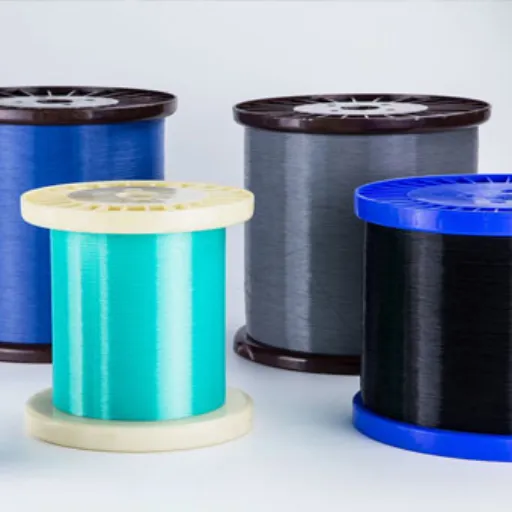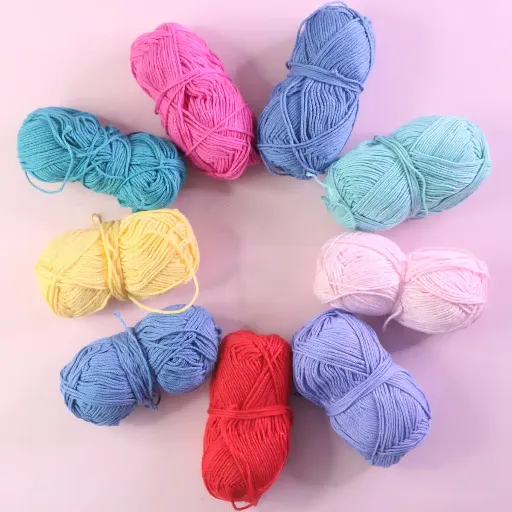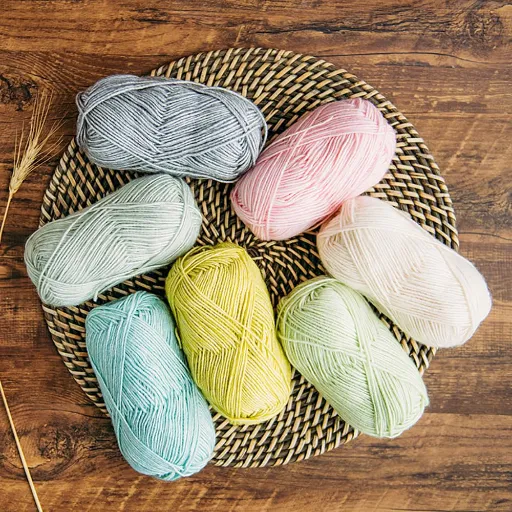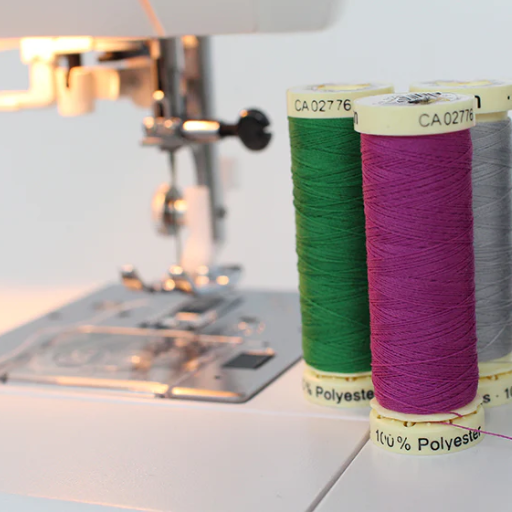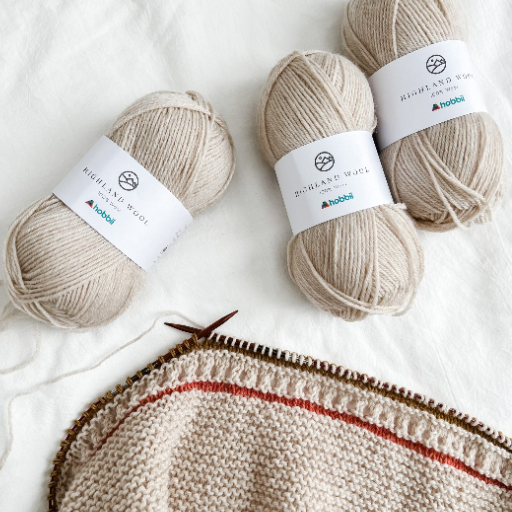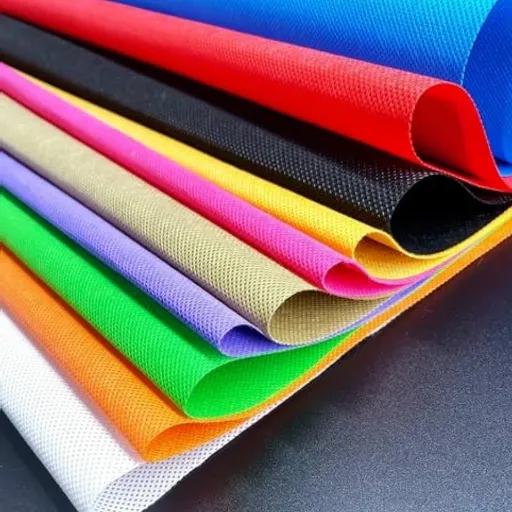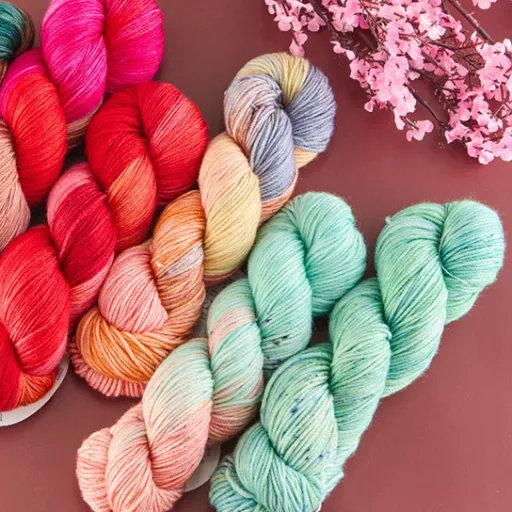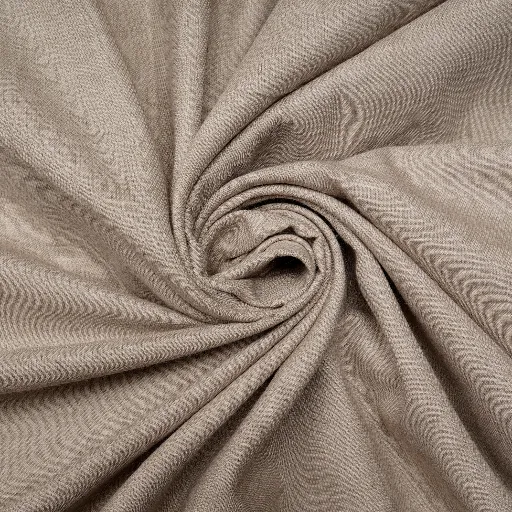Whenever one thinks of cotton or acrylic yarn, it is mostly associated with which one is more suitable for crochet projects. It is true that each has its own properties. Are you after a yarn that is beloved for its versatility or peerless durability? Knowing the main characteristics of cotton and acrylic yarn will answer questions, empowering decisions that suit your designing aims. The following article will summarize the significant features, benefits and ideal applications of both so that you can craft masterpieces for your crochet projects.
What is Cotton Yarn?
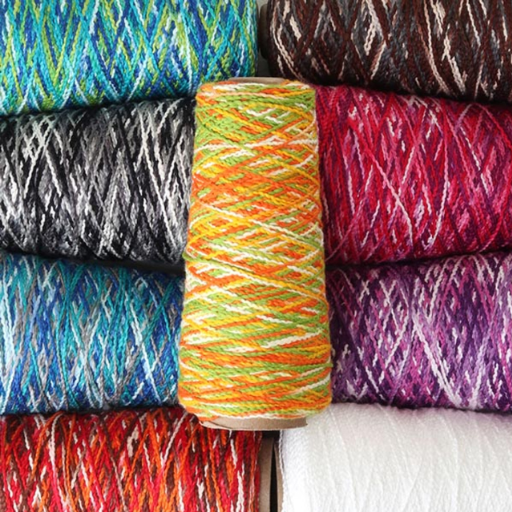
Cotton yarn features a fiber that can be distinguished as a “natural” and comes from the seed of the cotton plant. People prefer this type of yarn because it’s soft, breathable, and seamless to work with, gentle on warm clothing, as well as home accessories. From the perspective of crafting, this yarn type is very useful because it comes with the advantages of strong absorption rate, hypoallergenic properties, as well as skin-friendliness. Most importantly, cotton remains shaped well when washed and is highly durable making it quite convenient for crafting items.
Understanding Cotton Yarn’s Properties
The outcomes that can be achieved with cotton yarn are directly linked to the performance features of the fiber’s composition. Cotton yarns’ cotton fiber components which are made up of cellulose polymer, provides high strength and flexibility. During the knitting, crocheting and weaving of cotton yarns, the tensile strength of the fibers enables them to endure a huge amount of stress without breaking. Another one of cotton’s benefits is its hygroscopic properties. This makes cotton yarns ideal for those garments that are required to be comfortable in humid conditions. It also works to cool the wearer by dissipating excess heat, and its thermal conductivity further enhances this ability. Balanced pilling, even color uptake throughout the fibers and uniform fiber quality are now ensured thanks to recent advancements in cotton yarn manufacturing processes. An environmentally friendly bioproduct, cotton’s ecological footprint is reduced when it is composted and naturally degraded under appropriate conditions.
Benefits of Using Cotton Yarn
- Breathability and Moisture Absorption
The breathable properties of cotton yarn improve air circulation, which regulates body temperature in different environmental conditions. Maintaining comfort during physical exertion in humid environments is effortless, with moisture absorption up to 27 times.
- Durability and Longevity
A high-quality cotton yarn sustains impressive cotton staple strength, boasting a remarkable 3.0- 4.9 grams per denier when dry. This guarantees cotton-based textiles can stand up to multiple uses and washing without considerable wear and tear. Blending cotton with other fibers increases durability for specific applications.
- Hypoallergenic Properties
Gentle on the skin, cotton is non-irritating and minimizes allergies. For sensitive skin, the soft texture and lack of harsh chemicals makes treated cotton yarn suitable for clothing and beddings.
- Versatility in Applications
Cotton yarns and threads can be applied in fashion, home furnishings, and even industrial textiles. It can be easily dyed and woven or even blended with synthetic fibers. It can also be used in manufacturing medical materials like bandages. The efficient and precise production outcomes guarantee strengthened compatibility with advanced manufacturing methods.
Cotton’s utility and reliability reinforce the benefits in diverse industries. It fortifies cotton yarn’s role as a staple in textiles.
Best Projects for Cotton Yarn
With regard to comfort, breathability, and strength, cotton yarn rates the highest among all the other types of yarn. Clothing cotton yarn for knitting or crocheting includes summer tops, lightweight scarves, and infant garments aimed at children because of its soft texture and ability to wick moisture. Cushion covers, dishcloths, as well as placemats are also home decor projects that add to a dish’s aesthetic value while being easy to maintain and durable.
Textile engineers exposed advanced functions of cotton yarn by using it in making eco-friendly reusable bags because it’s natural fibers are biodegradable and sustainable. As a craft, cotton yarn is used to make macrame hangers of plants and wall hangings as it gives uniform thickness and holds knots firmly. With these advantages and its versatility, cotton yarn can be used in many practical and intellectual artworks.
What’s the Acrylic Yarn?
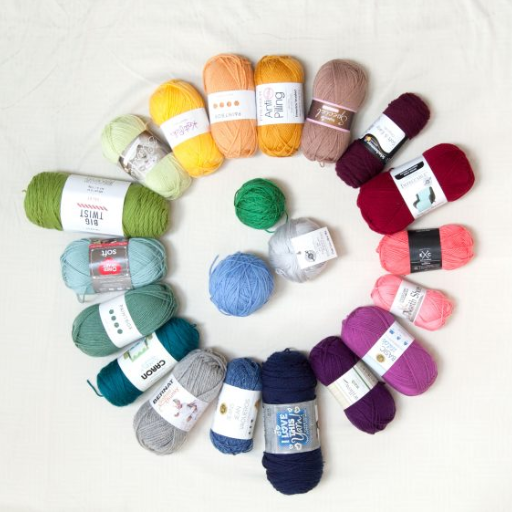
Acrylic yarn is a type of fiber that is produced from petrochemicals. It is made from the same products that acrylonitrile comes from. Abrasions, spills, and heavy handling are things which natural fibers like wool deal with effortlessly. Just like such fibers, acrylic yarn is built to imitate the softness and warmth of wool. In addition, it also resists wear and tear. Compared to other kinds of yarn, acrylic one is the lighter version. It is also gentler to the skin, easier to clean, and maintains its form after washing. Because these qualities make acrylic fibers useful when undertaking any form of textile work (such as knitting, crochet, or weaving), they can easily be considered a good value.
Characteristics of Acrylic Yarn
- Lightweight and Soft Texture
The synthetic origins of acrylic yarn do not make it any less comfortable, especially on clothing or accessories, as it is lightweight like natural fibers such as wool.
- High Durability
Such properties mean that products made out of acrylic yarn will not get easily damaged over time, especially items that are blankets or winter sweaters which will be subjected to more heavy use over their lifespan.
- Moisture Resistance
Such fabrics with low moisture absorption are also mildew resistant. These fibers are acrylic in nature which makes them easier to dry after washing clothes.
- Color Vibrancy and Retention
Acrylic yarn has the ease of being white chosen for dyeing at the right stage in production. Therefore, it can be made to hold vibrant colors easily. In addition to that, the yarn shows strength against fade even after washing or extended sun exposure.
- Hypoallergenic Properties
There are no animal fibers due to it being synthetic. Therefore, this type of yarn is perfect for those with allergy to wool or sensitive skin.
These qualities show how practical and flexible in use acrylic yarn are, thus an important material for the textile and handicrafts industry.
Advantages of Acrylic Yarn
- Durability and Longevity
Acrylic yarn does not break down easily, which makes it ideal to be used for a garments that are exposed to rough use and washing. It does not get worn out easily. Because of this, items such as blankets, sweaters and scarves can easily be made with these materials. Research also suggests that acrylic fibers can retain as much as 90% of their tensile strength after many cycles of machine wash and dry.
- Affordability
Acrylic yarn is much more affordable compared to other textiles like wool or silk. The synthetic approach enables easier mass production, driving the price down. It becomes easier to purchase as a hobby, and also helps in catering to large scale textile production.
- Ease of Maintenance
Compared to other fibers, acrylic yarn needs less caring. It is mostly machine washable and does not need special detergents or processes. It also dries quicker than wool making it more convenient for everyday use.
- Wide Range of Colors and Textures
Acrylic yarn can be produced in almost any color and hue, soft pastel shades, bright, and even vivid colors due to the new improvements in dying technology. The fibers are also diverse to work with and gives the manufacturers the ability to produce yarns that simulate natural wool or cotten fibers.
All these benefits together explain why acrylic yarn is still a favored choice for commercial textile production as well as individual crafting projects. The unmistakable low price, long life, and adaptability appeals to buyers from all corners of the world.
Ideal Uses for Acrylic Yarn
Knit sweaters, scarves, and hats are some examples of clothing made with acrylic yarn. Due to its softness, warmth, light weight, and moisture resistant properties , acrylic yarn is also used to create home textiles such as cushions, rugs, and blankets. Because items made with acrylic yarn retain their color, they are great for household textiles which require frequent cleaning.
Needless to say, crafters utilize this yarn in knitting and crocheting because it works well with many stitches and patterns. Rather, its cost-efficient nature allows for creative freedom, which adds warmth and comfort during cold winters. Moreover, in the filtration systems and composite structures, acrylate is used due to its strength; these yarns find use in virtually all old age hobby crafts. Furthermore, it is used for braids, upholstery fabrics, and in textile plants for large-scale production due to its strength and long-lasting colored vibrancy. Therefore, and aside from crafting, yarn serves industrial purposes, making its versatility between artistic and useful cross domains vital in textile creation.
Cotton vs Acrylic: Which is Better for Your Project?

It is very useful to understand the requirements of your project before coming to a decision between cotton and acrylic. Consider Project Requirements. Breathability and moisture absorption makes cotton work as a natural fiber which means it softens and is gentle on the skin. Because of this quality of cotton, it works extremely well for garments, home textiles. It becomes very useful in warm climates. However, with time and if not taken care of, it tends to lose shape or shrink.
Acrylic on the synthetic fiber end is loved for its durability and affordability. It is light and warm while also retaining its shape, making it great for things like winter clothing and other specialty warm apparel, blankets, and various accessories. Talking about flexibility, acrylic does not tend to shrink like cotton and is easier to care for a clean. Nonetheless, it does not possess the breathability and softness of natural fibers.
Comparing the differences between Cotton Yarn and Acrylic Yarn
|
Key Point |
Cotton Yarn |
Acrylic Yarn |
|---|---|---|
|
Fiber Origin |
Natural (plant-based) |
Synthetic (man-made) |
|
Durability |
Moderate |
High |
|
Maintenance Requirements |
Requires careful handling |
Easy to care for |
|
Breathability |
Highly breathable |
Limited breathability |
|
Softness |
Soft and comfortable |
Less soft compared to cotton |
|
Moisture Absorption |
High moisture absorption |
Low moisture absorption |
|
Resistance to Shrinking |
Prone to shrinking |
Resistant to shrinking |
|
Color Retention |
Fades over time |
Highly fade-resistant |
|
Weight |
Dense and slightly heavy |
Lightweight |
|
Thermal Properties |
Cooling effect, suitable for warmer climates |
Warm, ideal for colder climates |
|
Affordability |
Varies, often more expensive |
Generally affordable |
|
Environmental Impact |
Biodegradable, eco-friendly |
Non-biodegradable, less eco-friendly |
|
Texture |
Natural and soft |
Smooth, sometimes less pleasant |
Cost Considerations: Acrylic vs Cotton
First and foremost, we have to take into account the difference in pricing of cotton yarn and acrylic yarn. The most noticeable fact about acrylic yarn is its popularity among people working on large-scale projects or the novice who is embarking on a new hobby because of its lower pricing. On the other hand, because cotton is a natural product and requires a lot of labor in its growing, picking and manufacturing stages, it is more pricey than acrylic yarn.
Market trends indicate that acrylic yarn’s lower production cost stems from its synthetic nature, allowing manufacturers to produce it on a large scale without reliance on agricultural cycles. Remember that agriculture is heavily involved in the determination of prices of cotton yarn due to the productivity of cotton growing crops, seasons, demand from overseas, climate conditions in the particular year, and so forth. While acrylic yarn offers financial savings, its long-term value should also account for potential environmental costs due to non-biodegradability. For projects where sustainability is prioritized, cotton may present a more justifiable investment despite the premium price. In my opinion, with these materials, the most important is the budget, longevity of the things, eco-friendly aspects of the project.
Choosing the Right Yarn for Your Crochet Project
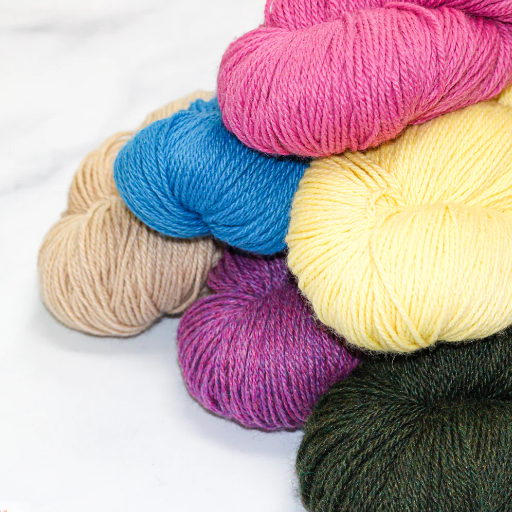
- Project Type
Think about the purpose of your project. For functional items like blankets or clothes to wear, the durability and ease of washing wool is essential. These features make acrylic a practical choice, especially with its lower price and machine-washable properties. Textures and colors take precedence for decorative pieces, making specialty or natural fibers ideal.
- Skill Level
The easiest to work with and make stitch patterns easier to see is medium-weight yarn, which goes by worsted weight. Beginners will appreciate this type of yarn, along with smooth textures.
- Budget Constraints
While high quality and eco-friendly projects might use natural fibers such as wool or cotton, acrylic yarn is a very cost effective alternative along with synthetic fiber glass wool.
- Environmental Impact
In this case, the best option would be natural, biodegradable cotton and bamboo fibers. Unlike acrylic, these have a much lower environmental impact.
All of these elements work together to assist in choosing the yarn and guarantee that your crochet project is satisfying in appearance as well as purpose.
Cotton and Acrylic: Blends and Alternatives
Cotton and acrylic yarn blends give you the best of both worlds as they fuse natural and synthetic fibers. This blend is also suitable because cotton is breathable and moisture-absorbent. This enhances comfort on garments, dishcloths and even summer projects. The only downside is that the lack of elasticity in pure cotton makes it not ideal for stretch-dependent applications. Cotton acrylic blend works well too, as it is lightweight and very durable to withstand warm projects. Also, best suited for the construction of garments because it maintains its quality over a long time.
The absorbency of cotton and its softness blended with the durability and elasticity of acrylic gives us a 50-50 split blend yielding a stronger material that is still breathable. This is why designers often select this blend for the infant’s garments as it does not irritate the skin, and its durability and ease of washing are extra advantages.
But there are even more options like the blends of cotton and bamboo, which is silky, eco-friendly, and biodegradable, or cotton-polyester, which is stronger and wrinkle-resistant. Knowing these fibers and their blends allows for meeting the specific requirements of your crochet or knitting projects. Crafters achieve the desired aesthetics, durability, and functionality of their creation by carefully examining the fiber content along with the structural features.
Project Types: When to Use Cotton or Acrylic
The moisture management and durability requirements of a project make cotton yarn an ideal choice for summer clothes, washable dishcloths, and even baby garments. Because cotton is hypoallergenic, it is also widely used on items that are intended for the people with sensitive skin. On the other hand, the low elasticity of cotton may not make it suitable for use in heavily stretchable designs.
Acrylic yarn is best for use in making cost effective and multifunctional gear as well as in the recreational sector. Because of the superb heat retention properties of acrylic, it is extremely useful in making cold weather apparel such as scarves, shawls and even sweaters. Also, acrylic is lightweight and resistant to fading as well as wear which makes it ideal for color work projects or even for high traffic items like rugs and blankets. Though lower in breathability than cotton, acrylic is easy to care for which makes it handy for everyday uses.
How Do Cotton and Acrylic Yarns Perform in Different Projects?
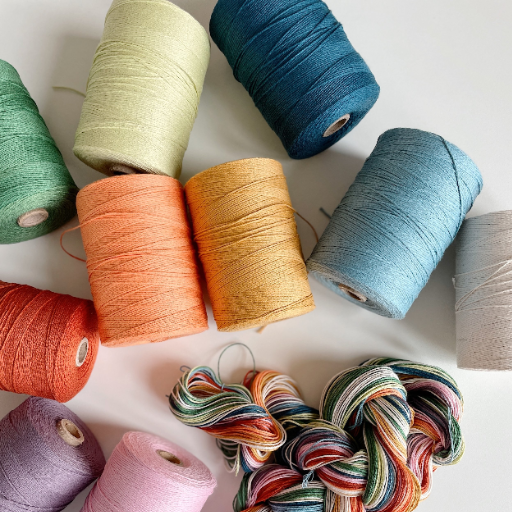
Cotton yarns work wonderfully for summer clothes, dishcloths, and market totes that need breathability and durability. The rod like structures in cotton fibers have great moisture absorbency.Their structural arrangement makes them very useful for things which are kept in water or highly humid areas. But the lack of elasticity with cotton products makes it ill suitable for stretchable or fitted garments.
Acrylic yarn is particularly useful in keeping one warm in the winter, as it can be used to make garments, blankets and hats. Its lightweight and durable nature allows it to be Vividly Colorful and Colorfast. While cotton is much more breathable, acrylic does have an advantage due to the fact that it is easier to machine wash and does not wear down easily. Picking one of the two is solely based on the requirements of the specific project.
Knit or Crochet: Best Practices for Each Yarn Type
Cotton yarn requires even tension all throughout the project as the lack of elasticity can make stitches uniform and loose. For knitters, smooth yarn enables better gliding on the needles so those with frosted tips help. For crocheters, hooks with a shallow throat allow for much better control over the yarn. Cotton’s breathability makes it easier to work with textured stitches or lacework which creates washcloths, market bags or light summer garments. If you believe your finished piece can shrink or lose dye, be sure to pre-wash your yarn.
As for acrylic yarn, look for plastic and bamboo hooks and needles which have some measure of grip. This will help counter the yarn’s slippery nature. As easy as it is for beginners, incorporating basic patterns, seasoned knitters and crocheters can also tackle much more complex stitch patterns like cables, ribbing, crochet, or other structural patterns because of the highly adaptable nature of acrylic yarn. Its smoothness helps maintain lightweight comfort during long crafting sessions, even on larger projects like blankets. Also, avoid blocking heat on acrylic pieces as high temperatures may cause synthetic fibers to melt or lose shape. Instead, spray and pin or steam distance blocking to safely shape the final product without direct contact.
Summer Garments: Which Yarn is More Suitable?
When choosing a yarn for summer garments, it should be comfortable, breathable, and durable. Cotton yarn stands out in this case. Being a fiber from a plant makes it useful for warm weather clothing because it breathes well and wicks moisture. Furthermore, cotton has a soft hand and comes in different weights and finishes, including smooth mercerized and rough unprocessed types.
Bamboo yarn is marketed as an eco-conscious alternative because of its lightweight composition that is easy to carry, feels silky, and is capable of temperature control: all the hallmarks of exquisite bamboo yarn. Its antibacterial and hypoallergenic properties further silkify its use in summer apparel. For those seeking some bounce, cotton-bamboo or cotton-linen blends bestow increased versatility with strength, thus ensuring ease of movement and comfort without compromising durability. A thoughtful analysis on the attributes of various threads makes it possible for designers to look stylish while beating the heat and humidity.
Reference Sources
-
Comfort Properties of Cotton-Acrylic Blends:
- This study examined the comfort-related properties of cotton, acrylic, and their blends.
- Findings showed that fabrics with higher acrylic content had better wicking and drying properties, making them more suitable for moisture management.
-
Performance of Recycled Acrylic Yarns:
- Investigated the properties of fabrics made from recycled acrylic yarns.
- Recycled acrylic fabrics exhibited higher thickness, pilling tendency, and abrasion resistance but lower bursting strength compared to virgin acrylic fabrics.
-
Comparison of Cotton and Acrylic Socks:
- A longitudinal study on runners compared cotton and acrylic socks.
- Results indicated no significant difference in blister prevention or moisture management when using a generic cushion sole design.
Frequently Asked Questions (FAQs)
Q: What is the main difference between acrylic vs cotton yarn?
A: The primary difference lies in their composition. Acrylic yarn is a synthetic fiber, while cotton yarn is made from the fibers of the cotton plant. This distinction affects their texture, absorbency, and how they behave in different projects.
Q: Which is better for baby items: acrylic or cotton yarn?
A: Cotton yarn is often recommended for baby items due to its natural fibers and high absorbency, making it gentle on sensitive skin. However, acrylic yarn can also be a good choice as it is soft and durable, but ensure it is safe and hypoallergenic.
Q: Can I mix acrylic and cotton yarn in my projects?
A: Yes, many crafters use a cotton blend, which combines the benefits of both yarn types. This mixture can enhance the texture and durability of your finished product, making it suitable for various projects.
Q: What are the different types of cotton yarn available?
A: There are several types of cotton yarn, including mercerized cotton, which has a shiny finish, and organic cotton, which is produced without chemicals. Each type varies in texture, absorbency, and suitability for specific projects.
Q: How does absorbency compare between acrylic vs cotton yarn?
A: Cotton yarn has superior absorbency compared to acrylic yarn, making it ideal for projects like dishcloths or summer garments. Acrylic yarn is less absorbent but dries quickly, making it great for items that don’t need to retain moisture.
Q: Is acrylic yarn a good choice for amigurumi projects?
A: Yes, acrylic yarn is often favored for amigurumi because it holds its shape well and is available in a wide range of colors. Its durability makes it suitable for toys that will be handled frequently.
Q: How do the textures of acrylic and cotton yarn differ?
A: The texture of acrylic yarn is generally softer and smoother, while cotton yarn has a more textured, natural feel. This difference can affect the overall look and feel of your finished crochet projects.
Q: What should I consider when choosing yarn for your project?
A: When choosing yarn, consider the project type, desired texture, absorbency, and care requirements. For example, if you need a soft and durable yarn for a sweater, you might opt for acrylic, while a summer top might benefit from cotton’s breathability.
Q: Are there any downsides to using acrylic yarn?
A: While acrylic yarn is affordable and versatile, it can be less breathable than cotton and may cause discomfort in hot weather. Additionally, it’s not as eco-friendly as natural fibers like cotton.








